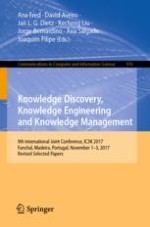2019 | Book
Knowledge Discovery, Knowledge Engineering and Knowledge Management
9th International Joint Conference, IC3K 2017, Funchal, Madeira, Portugal, November 1-3, 2017, Revised Selected Papers
Editors: Ana Fred, Prof. David Aveiro, Jan L. G. Dietz, Dr. Kecheng Liu, Jorge Bernardino, Ana Salgado, Joaquim Filipe
Publisher: Springer International Publishing
Book Series : Communications in Computer and Information Science
